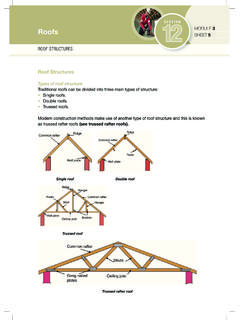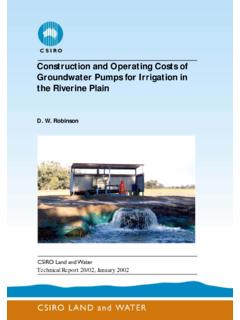Transcription of Foundation Maintenance and Footing Performance - …
1 Soil TypesThe types of soils usually present under the topsoil in land zoned forresidential buildings can be split into two approximate groups granular and clay. Quite often, Foundation soil is a mixture of bothtypes. The general problems associated with soils having granularcontent are usually caused by erosion. Clay soils are subject tosaturation and swell/shrink for a given area can generally be obtained byapplication to the local authority, but these are sometimes unreliableand if there is doubt, a geotechnical report should be most buildings suffering movement problems are founded on claysoils, there is an emphasis on classification of soils according to theamount of swell and shrinkage they experience with variations ofwater content.
2 The table below is Table from AS 2870, theResidential Slab and Footing of MovementSettlement due to constructionThere are two types of settlement that occur as a result ofconstruction: Immediate settlement occurs when a building is first placed on itsfoundation soil, as a result of compaction of the soil under theweight of the structure. The cohesive quality of clay soil mitigatesagainst this, but granular (particularly sandy) soil is susceptible. Consolidation settlement is a feature of clay soil and may takeplace because of the expulsion of moisture from the soil or becauseof the soil s lack of resistance to local compressive or shear will usually take place during the first few months afterconstruction, but has been known to take many years inexceptional problems are the province of the builder and should be takeninto consideration as part of the preparation of the site for construc-tion.
3 Building Technology File 19 (BTF 19) deals with theseproblems. ErosionAll soils are prone to erosion, but sandy soil is particularly susceptibleto being washed away. Even clay with a sand component of say 10%or more can suffer from is particularly a problem in clay soils. Saturation creates a bog-like suspension of the soil that causes it to lose virtually all of itsbearing capacity. To a lesser degree, sand is affected by saturationbecause saturated sand may undergo a reduction in volume particularly imported sand fill for bedding and blinding , this usually occurs as immediate settlement and shouldnormally be the province of the swelling and shrinkage of soilAll clays react to the presence of water by slowly absorbing it, makingthe soil increase in volume (see table below).
4 The degree of increasevaries considerably between different clays, as does the degree ofdecrease during the subsequent drying out caused by fair weatherperiods. Because of the low absorption and expulsion rate, thisphenomenon will not usually be noticeable unless there areprolonged rainy or dry periods, usually of weeks or months,depending on the land and soil characteristics. The swelling of soil creates an upward force on the footings of thebuilding, and shrinkage creates subsidence that takes away thesupport needed by the Footing to retain failureThis phenomenon occurs when the Foundation soil does not havesufficient strength to support the weight of the Footing .
5 There aretwo major post-construction causes: Significant load increase. Reduction of lateral support of the soil under the Footing due toerosion or excavation. In clay soil, shear failure can be caused by saturation of the soiladjacent to or under the can and often do move. This movement can be up, down, lateral or rotational. The fundamental causeof movement in buildings can usually be related to one or more problems in the Foundation soil. It is important forthe homeowner to identify the soil type in order to ascertain the measures that should be put in place in order toensure that problems in the Foundation soil can be prevented, thus protecting against building movement.
6 This Building Technology File is designed to identify causes of soil-related building movement, and to suggestmethods of prevention of resultant cracking in buildings. Foundation Maintenanceand Footing Performance :A Homeowner s GuideGENERAL DEFINITIONS OF SITE CLASSESC lassFoundationAMost sand and rock sites with little or no ground movement from moisture changesSSlightly reactive clay sites with only slight ground movement from moisture changesMModerately reactive clay or silt sites, which can experience moderate ground movement from moisture changesHHighly reactive clay sites, which can experience high ground movement from moisture changesEExtremely reactive sites, which can experience extreme ground movement from moisture changesA to PFilled sites PSites which include soft soils.
7 Such as soft clay or silt or loose sands; landslip; mine subsidence; collapsing soils; soils subject to erosion; reactive sites subject to abnormal moisture conditions or sites which cannot be classified otherwise BTF 18replacesInformationSheet 10/91 Tree root growthTrees and shrubs that are allowed to grow in the vicinity of footingscan cause Foundation soil movement in two ways: Roots that grow under footings may increase in cross-sectionalsize, exerting upward pressure on footings . Roots in the vicinity of footings will absorb much of the moisturein the Foundation soil, causing shrinkage or of MovementThe types of ground movement described above usually occurunevenly throughout the building s Foundation soil.
8 Settlement dueto construction tends to be uneven because of: Differing compaction of Foundation soil prior to construction. Differing moisture content of Foundation soil prior to due to non-construction causes is usually more unevenstill. Erosion can undermine a Footing that traverses the flow or cancreate the conditions for shear failure by eroding soil adjacent to afooting that runs in the same direction as the flow. Saturation of clay Foundation soil may occur where subfloor wallscreate a dam that makes water pond. It can also occur wherever thereis a source of water near footings in clay soil.
9 This leads to a severereduction in the strength of the soil which may create local swelling and shrinkage of clay soil affects the perimeter ofthe building first, then gradually spreads to the interior. The swellingprocess will usually begin at the uphill extreme of the building, or onthe weather side where the land is flat. Swelling gradually reaches theinterior soil as absorption continues. Shrinkage usually begins wherethe sun s heat is greatest. Effects of Uneven Soil Movement on StructuresErosion and saturationErosion removes the support from under footings , tending to createsubsidence of the part of the structure under which it walls will resist the stress created by this removal ofsupport by bridging the gap or cantilevering until the bricks or themortar bedding fail.
10 Older masonry has little resistance. Evidence offailure varies according to circumstances and symptoms may include: Step cracking in the mortar beds in the body of the wall orabove/below openings such as doors or windows. Vertical cracking in the bricks (usually but not necessarily in linewith the vertical beds or perpends).Isolated piers affected by erosion or saturation of foundations willeventually lose contact with the bearers they support and may tilt orfall over. The floors that have lost this support will become bouncy,sometimes rattling ornaments swelling/shrinkage in claySwelling Foundation soil due to rainy periods first lifts the mostexposed extremities of the Footing system, then the remainder of theperimeter footings while gradually permeating inside the buildingfootprint to lift internal footings .










